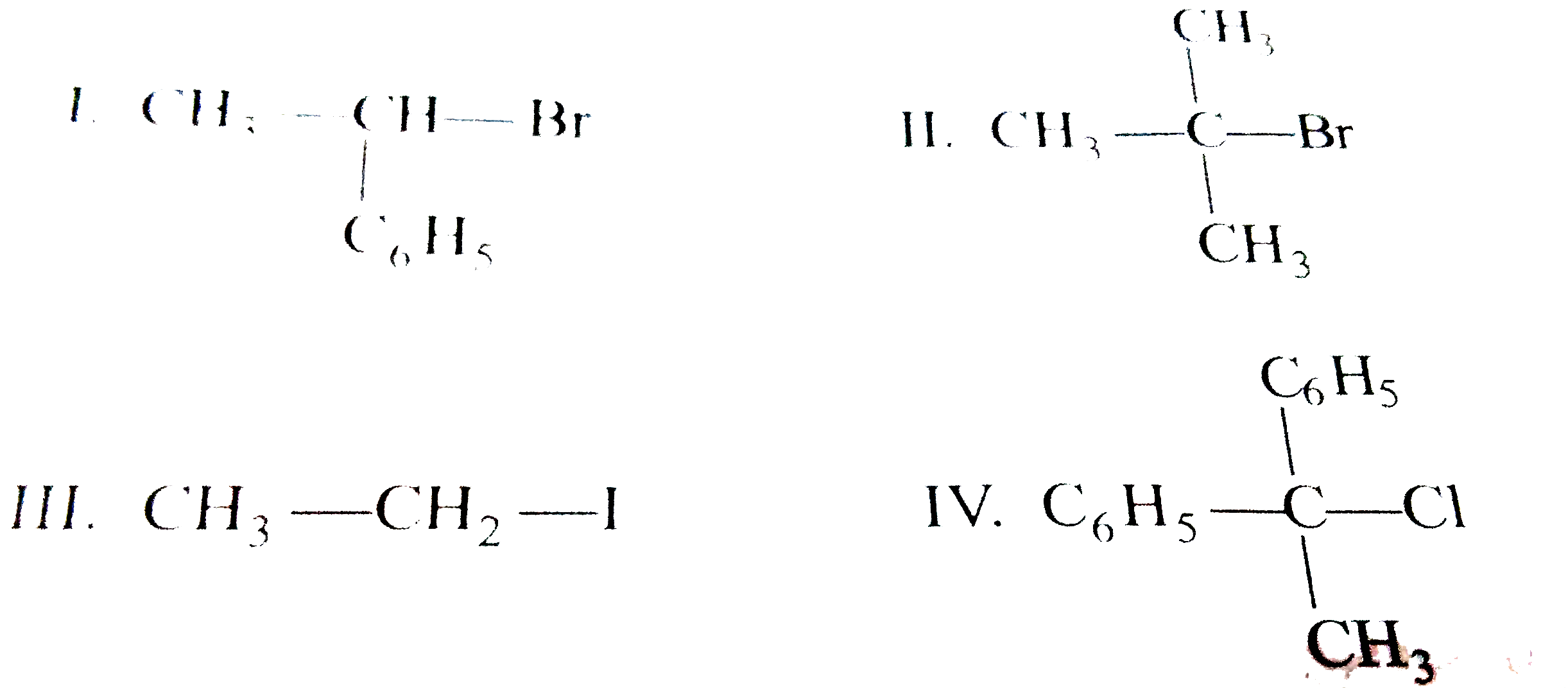Complete Solutions to PASSAGE-I of chapter BASIC PRINCIPLES OF ORGANIC COMPOUNDS (MECHANISM OF ORGANIC REACTIONS) of Class 12 book with complete answers and questions
| Class 12 | CHEMISTRY |
| Chapter | BASIC PRINCIPLES OF ORGANIC COMPOUNDS (MECHANISM OF ORGANIC REACTIONS) |
| OP TANDON | PASSAGE-I |
| Number Of Questions | 5 |
| Academic Year | 2023-24 |
Nuclephilic substitution reaction is given by those compounds which have nucleophilic groups as leaving groups. The weaker the basicity of a group of the substrate, the better is its leaving ability.
In nucleophilic substitution reactions, the basicity of leaving group should be less than the incoming nucleophilic group. Nucleophilc substitution reaction at `sp^(3)` -hybridised carbon is either bimolecular `(S_(N^(2)))` or unimolecular `(S_(N^(1)))`. Bimolecular reaction takes place in single step, involving transition state intermediate. In `S_(N^(2))` reaction is preferred if the compound has less steric hindrance.
Unimolecular `(S_(N^(2)))` reaction involves two steps and carbonium ion intermediate. Optically active substrates give recemic mixture in these reactions.
Which compound will give Walden inversion in `S_(N^(2))` reaction?
View SolutionNuclephilic substitution reaction is given by those compounds which have nucleophilic groups as leaving groups. The weaker the basicity of a group of the substrate, the better is its leaving ability.
In nucleophilic substitution reactions, the basicity of leaving group should be less than the incoming nucleophilic group. Nucleophilc substitution reaction at `sp^(3)` -hybridised carbon is either bimolecular `(S_(N^(2)))` or unimolecular `(S_(N^(1)))`. Bimolecular reaction takes place in single step, involving transition state intermediate. In `S_(N^(2))` reaction is preferred if the compound has less steric hindrance.
Unimolecular `(S_(N^(2)))` reaction involves two steps and carbonium ion intermediate. Optically active substrates give recemic mixture in these reactions.
Which among the following will give `S_(N^(1))` reaction?

View SolutionNuclephilic substitution reaction is given by those compounds which have nucleophilic groups as leaving groups. The weaker the basicity of a group of the substrate, the better is its leaving ability.
In nucleophilic substitution reactions, the basicity of leaving group should be less than the incoming nucleophilic group. Nucleophilc substitution reaction at `sp^(3)` -hybridised carbon is either bimolecular `(S_(N^(2)))` or unimolecular `(S_(N^(1)))`. Bimolecular reaction takes place in single step, involving transition state intermediate. In `S_(N^(2))` reaction is preferred if the compound has less steric hindrance.
Unimolecular `(S_(N^(2)))` reaction involves two steps and carbonium ion intermediate. Optically active substrates give recemic mixture in these reactions.
Which among the following will give enantiomeric pair on treatment with HOH?
View SolutionNuclephilic substitution reaction is given by those compounds which have nucleophilic groups as leaving groups. The weaker the basicity of a group of the substrate, the better is its leaving ability.
In nucleophilic substitution reactions, the basicity of leaving group should be less than the incoming nucleophilic group. Nucleophilc substitution reaction at `sp^(3)` -hybridised carbon is either bimolecular `(S_(N^(2)))` or unimolecular `(S_(N^(1)))`. Bimolecular reaction takes place in single step, involving transition state intermediate. In `S_(N^(2))` reaction is preferred if the compound has less steric hindrance.
Unimolecular `(S_(N^(2)))` reaction involves two steps and carbonium ion intermediate. Optically active substrates give recemic mixture in these reactions.
Select the correct statements among the following:
View SolutionNuclephilic substitution reaction is given by those compounds which have nucleophilic groups as leaving groups. The weaker the basicity of a group of the substrate, the better is its leaving ability.
In nucleophilic substitution reactions, the basicity of leaving group should be less than the incoming nucleophilic group. Nucleophilc substitution reaction at `sp^(3)` -hybridised carbon is either bimolecular `(S_(N^(2)))` or unimolecular `(S_(N^(1)))`. Bimolecular reaction takes place in single step, involving transition state intermediate. In `S_(N^(2))` reaction is preferred if the compound has less steric hindrance.
Unimolecular `(S_(N^(2)))` reaction involves two steps and carbonium ion intermediate. Optically active substrates give recemic mixture in these reactions.
`S_(N^(2))` reaction involves transition state intermediate, hence it is favoured in which of the following solvents?
View Solution
PASSAGE-I questions and complete solutions for chapter BASIC PRINCIPLES OF ORGANIC COMPOUNDS (MECHANISM OF ORGANIC REACTIONS) of G.R. BATHLA & SONS CHEMISTRY (HINGLISH) of Class 12
All Exercises from OP TANDON Class 12 CHEMISTRY BASIC PRINCIPLES OF ORGANIC COMPOUNDS (MECHANISM OF ORGANIC REACTIONS)
- ASSERTION-REASON TYPE QUESTIONS
- BRAIN STORMING PROBLEMS
- ILLUSTRATIONS OF OBJECTIVE QUESTIONS
- MATRIX-MATCH TYPE QUESTIONS
- OBJECTIVE QUESTIONS (Level-A)
- OBJECTIVE QUESTIONS (Level-B)
- PASSAGE-I
- PASSAGE-II
- PASSAGE-III
- PASSAGE-IV
- PASSAGE-V
- PROBLEMS FOR PRACTICE
- SET II
- SINGLE INTEGER ANSWER TYPE QUESTIONS
- SOME SOLVED PROBLEMS